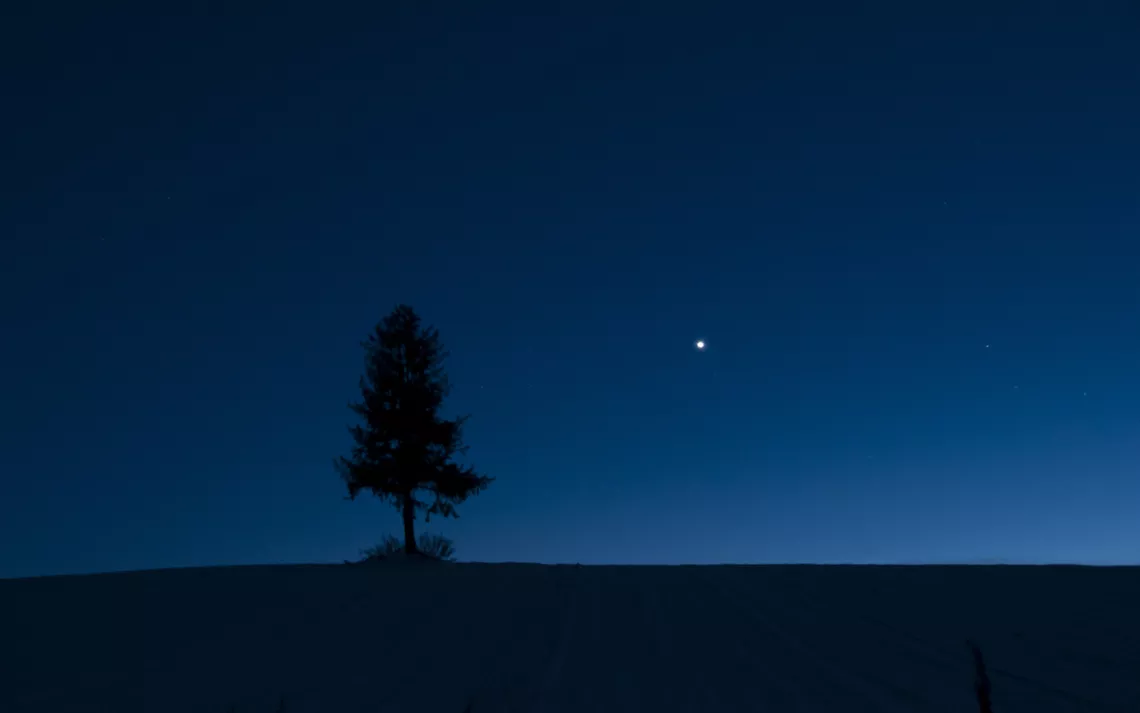December Observing Highlights: Hypnotic Venus and a Parade of Stars
This month the night sky is merry and bright

Photo by kinpouge05/iStock
Once more for those in the back: It’s not a plane; it’s Venus!
When Venus appears just above rooftops after sunset, its dazzling brightness means it is often mistaken for a plane or even a UFO. The clouds that cover Venus give it a high albedo, or reflectivity, making it the brightest planet seen from Earth. This is especially true this month, when Venus is the most eye-catching object in the night sky. It shines at magnitude -3.9 in the southeast for a couple hours after sunset, staying up longer as the month wears on.
On December 9, Venus is just below Saturn. On the following nights, it moves to the left and upward until the two planets are side by side. Around this time, they actually form a triangle with a third, unseen “planet.” On December 11, try to imagine that Venus and Saturn are two points of a nearly equilateral triangle, with a third point to their upper left. In that location, if you had an extremely large telescope, you would be able to spot the demoted planet, Pluto. On December 15, as Venus and Saturn continue to separate, imagine a line stretching between them—the midpoint on that line is where Pluto now lies. You can’t, of course, come anywhere close to seeing the 14.4-magnitude object, even with a backyard telescope, but it’s nice to know that it is there, floating in the far depths of the solar system.
On December 27, a 3-percent-lit young moon is close to Saturn, and on December 28, you can find the crescent moon below Venus. On this date, the moon is about 8 percent lit and 2.7 days old.
Winter Gems
For the Northern Hemisphere, winter officially arrives on December 21 at 8:19 P.M. PST. The longest, darkest nights occur now, but more sunlight will gradually inch its way into our skies with the New Year. For those up celebrating around midnight on December 31, winter constellations will be prominent and sparkling, including Orion, Taurus, Perseus, and Gemini. Don’t miss the Big Dipper toward the north, with its handle dangling down like an icicle.
Winter means that we are viewing the thinnest part of the Milky Way, turning away from some thick star clouds and nebulae, but some of the brightest stars reside in the winter sky. Look up, eliminate the planets, and then find the sharpest point of light. Most likely you’ve found Sirius in Canis Major, the brightest star in all the heavens. The next most visible star is Capella in Auriga, the 6th-brightest star. (Stars that are in the Southern Hemisphere or currently close to the sun aren’t visible for your time and location.) The next most visible stars in the winter skies are Rigel in Orion (7th brightest) and Procyon in Canis Minor (8th brightest). Reddish Betelgeuse at Orion’s shoulder is the 10th brightest, Aldebaran in Taurus is the 14th brightest, and Pollux in Gemini outshines his brother Castor and takes 17th place. Can you discern the difference in the stars’ rankings?
Meteors and More
This year’s peak of the Geminid Meteor Shower occurs overnight from December 13 to 14, but it falls just a day after the full moon on December 12, so observing conditions are not favorable. With around 100 meteors an hour, you may still catch a few bright fireballs.
The observing conditions for December’s second meteor shower, the Ursids, will have somewhat better conditions due to a waning moon. The peak is December 21–22, with up to 25 meteors an hour.
On December 26, an annular eclipse occurs around the Indian Ocean. The name comes from the word “annulus,” or ring. During an annular eclipse, a ring of light still surrounds the darkened sun, which means that this type of eclipse is not safe to observe without a solar filter.
 The Magazine of The Sierra Club
The Magazine of The Sierra Club







